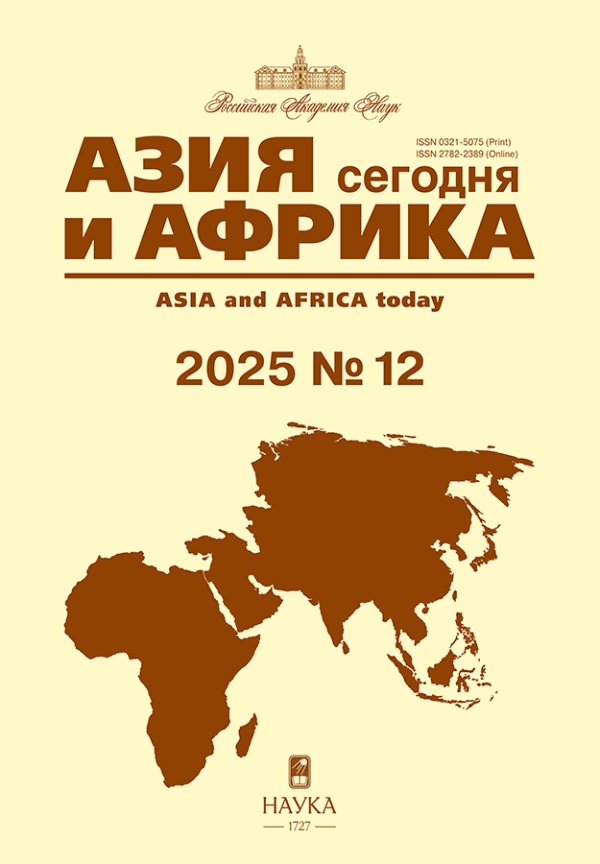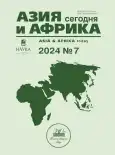Gender and Demographic Aspects of the Arab Spring Protests: Youth Bulges, Women’s Participation and the Role of Internet
- Authors: Shishkina A.R.1,2
-
Affiliations:
- HSE University
- Saint-Petersburg State University
- Issue: No 7 (2024)
- Pages: 49-56
- Section: Politics, economics
- URL: https://journals.rcsi.science/0321-5075/article/view/259858
- DOI: https://doi.org/10.31857/S032150750031389-9
- ID: 259858
Cite item
Full Text
Abstract
About the authors
Alisa R. Shishkina
HSE University; Saint-Petersburg State University
Email: alisa.shishkina@gmail.com
ORCID iD: 0000-0002-2544-9184
PhD (Political Science), Leading Researcher; Senior Researcher Moscow, Russia; St. Petersburg, Russia
References
- Moghadam M.V., Mako Sh. 2021. After the Arab Uprisings: Progress and Stagnation in the Middle East and North Africa. Cambridge University Press.
- Nisa E.F. 2021. Internet and Muslim Women. Handbook of contemporary Islam and Muslim lives.
- Shishkina A.R. 2017. Egyptian Women in the Arab Spring: Emotions, Political Participation, and the Internet. Non-Western Social Movements and Participatory Democracy: Protest in the Age of Transnationalism. Pp. 161–171.
- Glasius M., Pleyers G. 2013. The Global Movement of 2011: Democracy, Social Justice, and Dignity. Development and Change Forum 2013. Vol. 44. P. 554.
- Khamis S. 2011. The Arab “Feminist” Spring? Feminist Histories and Institutional Practices. Vol. 37. № 3. Pp. 692–695.
- Grinin L., Korotayev A. 2012. Does “Arab Spring” Mean The Beginning Of World System Reconfiguration? World Futures: The Journal of General Evolution. № 68. Iss. 7. Pp. 471–505.
- Duverger M. 1995. The Political Role of Women. Paris: UNESCO.
- Inglehart R., Norris P. 2003. Rising Tide: Gender Equality and Cultural Change Around the World. New York: Cambridge University Press. Pp. 123–126.
- Burton M.L., Reitz P. 1981. The plow, female contribution to agricultural substances, and polygyny. Behavior Science Research. № 16. Pp. 298–300.
- Hoffman M., Jamal A. 2011. The Youth and the Arab Spring: Cohort Differences and Similarities. Brill. http://booksandjournals.brillonline.com/content/journals/10.1163/187633712x632399 (accessed 15.01.2024)
- Retta J. 2013. Consequences of the Arab Spring for Women’s Political Participation. Journal of Women and Human Rights in the Middle East. Iss. 1. Pp. 20–30.
- Lengel L. 2012. Arab Women, Social Media, and the Arab Spring: Applying the framework of digital reflexivity to analyze gender and online activism. Journal of International Women’s Studies. Vol. 13, Iss. 5. Pp. 30–45.
- Stephan R. 2013. Cyberfeminism and its Political Implications for Women in the Arab World. E-International Relations. http://e-ir.info/2013/08/28/cyberfeminism-and-its-political-implications-for-women-in-the-arab-world/ (accessed 28.02.2024)
- Korotayev A.V., Issaev L.M., Malkov S.Y. and Shishkina A.R. 2014. The Arab spring: a quantitative analysis. Arab Studies Quarterly. Vol. 36. Iss. 2. Pp. 149–169.
- Mulderig M.C. 2013. An uncertain future: Youth frustration and the Arab Spring. Boston University.
- Urdal H. 2006. A Clash of Generations? Youth Bulges and Political Violence. International Studies Quarterly. № 50. Pp. 607–609.
- LeGraffe D. 2012. The Youth Bulge in Egypt: An Intersection of Demographics, Security and the Arab Spring. Journal of Strategic Security. Vol. 5. № 2. Pp. 63–80.
- Mohr G.A. 1966. Friend of the Wayward Youth. Alexander F., Eisenstein S., Grotjahn M. (ed.). New York: Psychoanalytic Pioneers. Pp. 348–359.
- Woodman D., Wyn J. 2015. Youth and Generation: Rethinking Change and Inequality in the Lives of Young People. Sage Publications Ltd.
- Pilcher J. 1994. Mannheim’s Sociology of Generations: An Undervalued Legacy. British Journal of Sociology. № 45(3). Pp. 481–495.
- Mannheim K. 1952. The Problem of Generations. Essays on the Sociology of Knowledge: Collected Works. Vol. 5. New York: Routledge. Pp. 276–322.
- Chesnais J.C. 1992. The Demographic Transition: Stages, Patterns, and Economic Implications. Oxford: Clarendon Press.
- Борисов В.А. Демография. 1999. Москва: Издательский дом NOTA BENE. Borisov V.A. 1999. Demography. Moscow. (In Russ.)
- Malthus T. 1978. Population: The First Essay. MI: University of Michigan Press.
- Цирель С.В. Условия возникновения революционных ситуаций в арабских странах. Системный мониторинг глобальных и региональных рисков: Арабская весна. 2012. С. 162–173. Tsirel S.V. 2011. Conditions for the emergence of revolutionary situations in Arab countries. Systemic monitoring of global and regional risks: Arab Spring. Pp. 162–173. (In Russ.)
- Коротаев А.В., Ходунов А.С., Бурова А.Н., Малков С.Ю., Халтурина Д.А., Зинькина Ю.В. Социально-демографический анализ Арабской весны. Системный мониторинг глобальных и региональных рисков: Арабская весна. 2012. Москва: ЛКИ. Korotayev A.V., Khodunov A.S., Burova A.N., Malkov S.Yu, Khalturina D.A., Zin’kina Yu.V. 2012. Socio-demographic analysis of the Arab Spring. System monitoring of global and regional risks: Arab Spring. Moscow. (In Russ.)
- Marks M. 2011. Determinants of Delayed Male Marriage in Egypt. The Stanford Journal on Muslim Affairs. № 2(1). Pp. 22–29.
- Puschmann P., Matthijs K. 2012. The Janus Face of the Demographic Transition in the Arab World. The Decisive Role of Nuptiality. Leuven.
- Korotayev A., Issaev L., Shishkina A., Malkov S.Y. 2013. Developing the Methods of Estimation and Forecasting the Arab Spring Events. Central European Journal of International and Security Studies. Vol. 7. № 4.
- Korotayev A., Issaev L., Shishkina A., Rudenko M.A., Ivanov Y. 2016. Afrasian Instability Zone and Its Historical Background. Social Evolution & History. Vol. 15. № 2. Pp. 120–140.
Supplementary files











